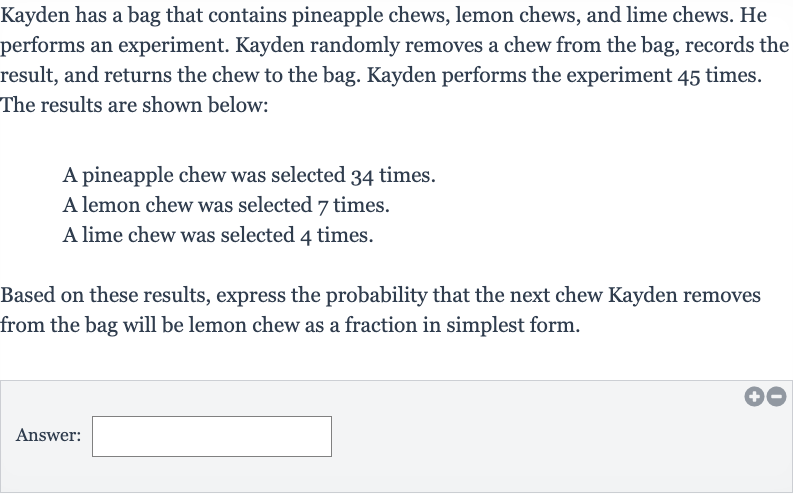AI tutor
Welcome to Bytelearn!
Let’s check out your problem:

Kayden has a bag that contains pineapple chews, lemon chews, and lime chews. He performs an experiment. Kayden randomly removes a chew from the bag, records the result, and returns the chew to the bag. Kayden performs the experiment times. The results are shown below:A pineapple chew was selected times.A lemon chew was selected times.A lime chew was selected times.Based on these results, express the probability that the next chew Kayden removes from the bag will be lemon chew as a fraction in simplest form.Answer:
Full solution
Q. Kayden has a bag that contains pineapple chews, lemon chews, and lime chews. He performs an experiment. Kayden randomly removes a chew from the bag, records the result, and returns the chew to the bag. Kayden performs the experiment times. The results are shown below:A pineapple chew was selected times.A lemon chew was selected times.A lime chew was selected times.Based on these results, express the probability that the next chew Kayden removes from the bag will be lemon chew as a fraction in simplest form.Answer:
- Calculate Probability: To find the probability of selecting a lemon chew, we need to divide the number of times a lemon chew was selected by the total number of chews selected.
- Identify Lemon Chews: The number of times a lemon chew was selected is given as .
- Total Chews Selected: The total number of chews selected is the sum of all the chews selected, which is (pineapple) + (lemon) + (lime) = .
- Calculate Fraction: Now we calculate the probability of selecting a lemon chew as a fraction: Probability = Number of lemon chews selected / Total number of chews selected = .
- Simplify Fraction: We check if the fraction can be simplified. Since and have no common factors other than , the fraction is already in its simplest form.
More problems from Find probabilities using the binomial distribution
QuestionGet tutor help
QuestionGet tutor help
QuestionGet tutor help
QuestionGet tutor help
QuestionGet tutor help
QuestionGet tutor help
QuestionGet tutor help
QuestionGet tutor help
QuestionGet tutor help
QuestionGet tutor help
